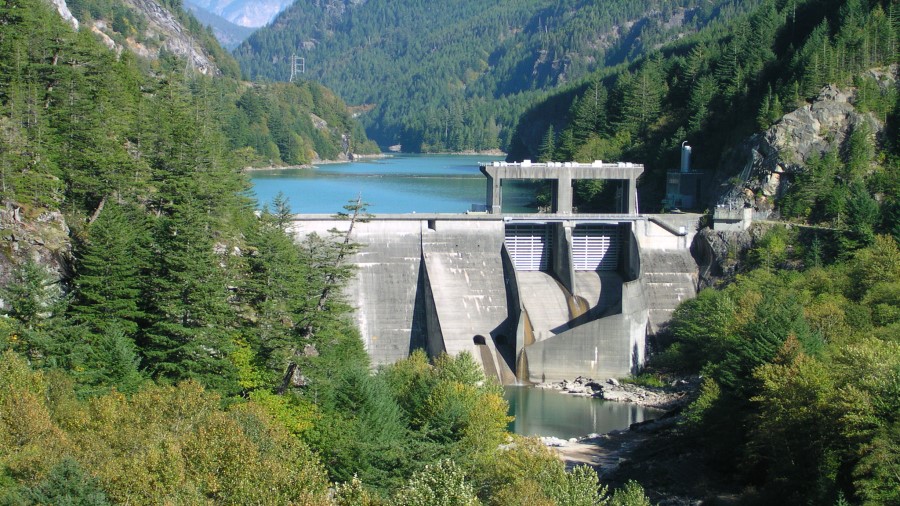Seattle City Light fights off lawsuits involving crucial hydroelectric dams, endangered salmon
Oct 5, 2021, 5:13 AM | Updated: Oct 8, 2021, 11:00 am

Gorge Dam, Skagit River (Courtesy "brewbooks" via Flickr)
(Courtesy "brewbooks" via Flickr)
With Seattle City Light (SCL) in the process of relicensing its dams on the Skagit River — hydroelectric projects that supply the City of Seattle with roughly 20% of its electricity — SCL has been slapped with a number of lawsuits which contend that their concrete barriers have stopped the resident orca whale population’s primary food source, Chinook salmon.
One of those lawsuits, filed by the Sauk-Suiattle Indian Tribe on June 30, argues that Seattle is in violation of federal and state law by obstructing the salmon population’s passage further into the Skagit, past the dams.
Skagit County also entered the fray with an open public records lawsuit against SCL on Aug. 23. They hold that the utility has not adequately invested into preservation of steelhead and Chinook populations.
Recent funding for Skagit River salmon restoration
On Sept. 21, Seattle City Council announced that it had approved a multi-million dollar SCL fund in support of salmon and trout restoration on the Skagit. Uses include “side channel habitat restoration, research into salmon habitats and patterns of fish-use, and acquisition of thousands of acres of land to protect important habitat,” per a SCL press release.
The money will serve as a bridge fund to ramp up “mitigation projects” for salmon until the dams are theoretically relicensed in 2025.
A key component to salmon restoration in the area will be the study of fish migration patterns on the Skagit River.
“Fish passage studies are part of a comprehensive set of more than 30 studies that will clarify the impacts on cultural resources, wildlife, habitat, recreation, and more,” the release clarifies.
Why the Skagit dam was originally constructed without fish passage
Seattle City Light has historically held that the Skagit River’s salmon population only partially surpasses its Gorge Skagit Dam into glacial headwaters in the North Cascades. According to its Federal Energy Regulatory Commission (FERC) pre-application, the river’s own natural topography in the form of large boulders has prevented further salmon migration, not the Gorge Dam itself.
“While some historical use of areas upstream from the Gorge by steelhead is suggested by anecdotal information gathered at the time of construction [in 1927], the preponderance of evidence indicates limited historical anadromous fish use of the Skagit River watershed upstream from the present location of the Gorge Powerhouse,” reads the FERC pre-application.
Presumably, that was the pretext for their status as one of the only dams in Washington without infrastructure that supports fish passage.
Seattle City Light’s efforts to facilitate fish passage through the Skagit’s dams
The public utility has since made it clear that they acknowledge the historic presence of Chinook salmon past the Gorge Dam, and they have agreed to study its extent to which the dam itself is responsible for preventing fish migration into the upper reaches of the Skagit River.
“I wouldn’t say that we reversed course,” SCL Communications Director Julie Moore said. “We have always said that there were partial barriers, but that didn’t mean that no fish got past those barriers. That was consistent with our filing with the FERC for the new license.”
“We have been pretty clear in all of our documentation that Chinook and steelhead have been able to bypass Gorge dam and migrate as far as Stetattle Creek,” Chris Townsend, City Light’s Natural Resources and Hydro Licensing Director, told MyNorthwest.
“It’s a really interesting story that goes back decades. Our position has always been that Chinook and steelhead have been able to make it up,” Townsend continued. “There are partial barriers and difficult regions for the fish to pass, but they are still able to make it.”
Townsend referenced ongoing studies into the nature of fish migration past the Skagit’s dams, and what future fish passage through them might look like. He referenced new modeling technology, not available when the dam was last licensed, that will allow insight into the nature of fish passage through the dams.
“We are doing studies to model the ideal flow conditions that would allow fish to pass through those barriers,” Townsend said. “You basically need to have a deep enough pool to enable the fish to have the energy to jump over the fall above the pool. We can now model that, where we couldn’t with the last license.”
“The Gorge dam would block any fish that would make it past that bypass reach.”
Townsend defended the public utility’s legacy as one which has supported salmon recovery efforts.
“Our efforts to protect Chinook have been successful,” Townsend continued. “There are fish that have declined over that period, but it isn’t directly related to the dams. If you look at the salmon recovery plan, the limiting factors include such things as limited habitat in estuaries.”
Seattle City Light is currently studying whether retrofitting the dams with fish passages or “ladders” is an appropriate mitigation strategy. While ladders have been successful on the Columbia River, for example, there are other options for ensuring that salmon have access to all parts of the Skagit River.
Another potential passage strategy is called “trap and haul,” which involves capturing adult salmon, hauling them in trucks upstream, then capturing their juveniles for the reverse trip.
That decision of which, if any, passage strategy to pursue is largely contingent on studying the extent to which the parts of the Skagit in contention are, in fact, suitable habitat for native fish.
“We are studying the feasibility of passage over all three of the dams,” Townsend said. “We’re looking at how we can get fish over the Gorge, but also Diablo and Ross, and we’re looking at the habitat potential behind each of the three dams.”
“We’ll be led by the science, and the decision of the agencies with regulatory authority as well as the tribes that have treaty rights. If they decide the best way for us to participate in salmon recovery is to provide fish passage, we are prepared to do that.”
The Outdoor Line’s Tom Nelson weighs in
On that subject of fish passage, The Outdoor Line’s Tom Nelson appeared on KIRO Radio’s Dori Monson Show to discuss the Skagit River, its dams, and solutions for preserving the Chinook and steelhead salmon, both of which are listed as endangered species.
“There’s a tremendous electrical demand by the city of Seattle,” Nelson said. “This causes the hydro projects to run a great deal of water through the dams. In doing so, they artificially manipulate the river levels. This is particularly detrimental to spawning [salmon] … a lot of these salmon and steelhead have been very, very vulnerable to this type of water manipulation or ramp rate.”
He alluded to some of the history of fish ladders in Washington state, particularly on the Columbia River.
“Most of the dams on the Columbia River have fish ladders,” Nelson continued. “The Skagit does not. There are no fish passage provisions on Ross, Gorge, or Diablo dams.”
“This is because of the false assertion way back when …that salmon could not swim past a little pinch point in the Skagit River,” he added. “It was the basis by which these dams were placed on the river with no passage considerations and no mitigation or hatchery for lost salmon run.”
He addressed a question about the possibility of retrofitting the Skagit River dams with fish ladders.
“I wouldn’t say it’s impossible,” Nelson responded. “This is something the city of Seattle should spend money on.”
Nelson addressed how salmon leave a footprint that could be traced, proving their historic presence should it be contested. Seattle City Light has made it clear that they acknowledge that salmon did in fact once run above the Gorge Dam, and that they are actively researching fish passage strategies.
“Research papers came out documenting ocean-born nutrients in both nitrogen and carbon isotopes,” Nelson added. “In other words, … salmon spawn in freshwater. They go live their lives in saltwater, feed in saltwater and in doing so, pack up a bunch of ocean born nutrients.”
“When these fish come back up the river and spawn, their carcasses are on the shore and they’re picked apart by predators, particularly bears, eagles, a whole bunch of stuff. These ocean born nutrients, due to the scattered nature of the carcass, are drug back into the forest and fed upon,” he explained. “These carbon and nitrogen isotopes are then present in particularly old growth forests. It would be not too difficult to document the presence of ocean born nutrients above the Skagit dams and disproving then the Seattle City Light’s contention that salmon didn’t move past the dam.”
“I believe Seattle City Light is going to be … on the hook for increased hatchery production, or, at the very least, fish passage into the upper Skagit drainage, which indeed flows back up into Canada,” he posited.
Chris Townsend contacted MyNorthwest to clarify that he did not intend to suggest that the Skagit River’s dams do not contribute to a decline in Chinook salmon. “I fully expect that there are actions we can take to further contribute to recovery,” Townsend wrote. Today’s date: Oct. 8, 2021












